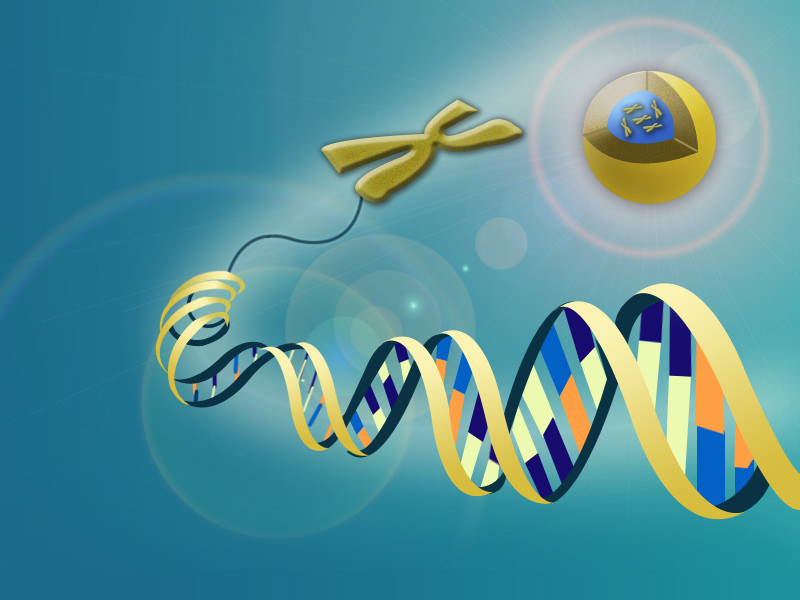3.2: Molecular Genetics Overview
- Page ID
- 13346

Did Mendel know about DNA?
No, people did not understand that DNA is our hereditary material until long after Mendel's time. Our modern understanding of DNA and chromosomes helped to explain how Mendel's rules worked.
Modern Genetics
Mendel laid the foundation for modern genetics, but there were still a lot of questions he left unanswered. What exactly are the dominant and recessive factors that determine how all organisms look? And how do these factors work?
Since Mendel’s time, scientists have discovered the answers to these questions. Genetic material is made out of DNA. It is the DNA that makes up the hereditary factors that Mendel identified. By applying our modern knowledge of DNA and chromosomes, we can explain Mendel’s findings and build on them. In this concept, we will explore the connections between Mendel’s work and modern genetics.
Traits, Genes, and Alleles
Recall that our DNA is wound into chromosomes. Each of our chromosomes contains a long chain of DNA that encodes hundreds, if not thousands, of genes. Each of these genes can have slightly different versions from individual to individual. These variants of genes are called alleles. Each parent only donates one allele for each gene to an offspring.
For example, remember that for the height gene in pea plants there are two possible factors. These factors are alleles. There is a dominant allele for tallness (T) and a recessive allele for shortness (t).
Genotype and Phenotype
Genotype is a way to describe the combination of alleles that an individual has for a certain gene (Table below). For each gene, an organism has two alleles, one on each chromosome of a homologous pair of chromosomes (think of it as one allele from Mom, one allele from Dad). The genotype is represented by letter combinations, such as TT, Tt, and tt.
When an organism has two of the same alleles for a specific gene, it is homozygous (homo means "same") for that gene. An organism can be either homozygous dominant (TT) or homozygous recessive (tt). If an organism has two different alleles (Tt) for a certain gene, it is known as heterozygous (hetero means different).
| Genotype | Definition | Example |
|---|---|---|
| Homozygous | Two of the same allele | TT or tt |
| Heterozygous | One dominant allele and one recessive allele | Tt |
| Homozygous dominant | Two dominant alleles | TT |
| Homozygous recessive | Two recessive alleles | tt |
Phenotype is a way to describe the traits you can see. The genotype is like a recipe for a cake, while the phenotype is like the cake made from the recipe. The genotype expresses the phenotype. For example, the phenotypes of Mendel’s pea plants were either tall or short, or they were purple-flowered or white-flowered.
Can organisms with different genotypes have the same phenotypes? Let’s see.
What is the phenotype of a pea plant that is homozygous dominant (TT) for the tall trait? Tall. What is the phenotype of a pea plant that is heterozygous (Tt)? It is also tall. The answer is yes, two different genotypes can result in the same phenotype. Remember, the recessive phenotype will be expressed only when the dominant allele is absent, or when an individual is homozygous recessive (tt) (Figure below).

Summary
- Mendel's hereditary "factors" are variants of genes called alleles.
- Genotype describes the combination of alleles that an individual has for a certain gene, while phenotype describes the traits that you can see.
Explore More
Use the resources below to answer the questions that follow.
Explore More I
- Link Between Genotype and Phenotype at https://www.sciencelearn.org.nz/videos/62-researching-the-link-between-genotype-and-phenotype
- When geneticists look at genotype, what are they really studying?
- Why do geneticists like to turn genes off? What question(s) do they ask?
Explore More II
- iPlant Genotype to Phenotype at http://www.youtube.com/watch?v=nIh0Qy_CZsU (3:49)
- Do most of the complex phenotypes we observe come from a single gene?
- What has led to the rapid analysis of DNA? Where do scientists now hope to apply these tools?
- What are some of the phenotypic plant traits that scientists are investigating? Why do you think these traits were chosen?
Review
- What is an allele?
- What is the type of allele that only affects the phenotype in the homozygous condition?
- If two individuals have a certain phenotype, does that mean they must have the same genotype?
- A tall, green plant is homozygous for each trait. If T is the tall allele, and G is the green allele, what is the genotype and the phenotype of this plant?

